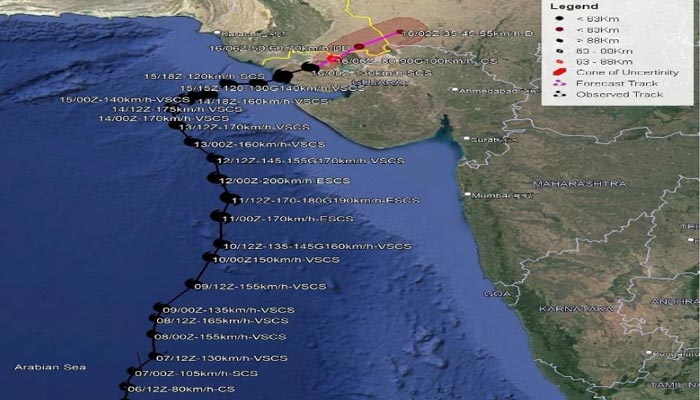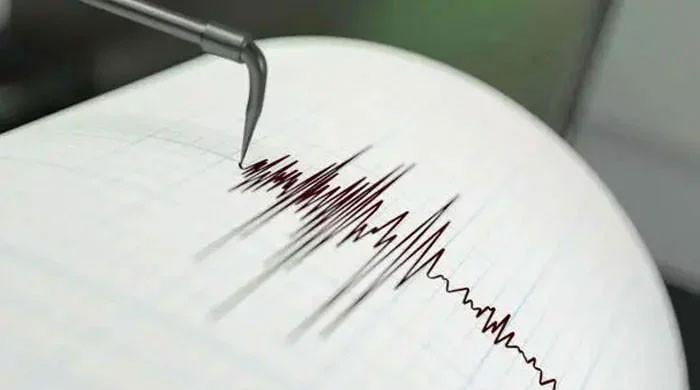Emergency lifted from Pakistan’s coastal areas as cyclone Biparjoy fizzles out
"Very severe cyclonic storm Biparjoy [...] has weakened into a severe cyclonic storm," PMD says
June 16, 2023

- "Biparjoy has weakened into severe cyclonic storm," PMD says.
- At least two people died in India's western state of Gujarat.
- Cyclone had no major impact on Pakistan.
Sindh's coastal residents, who were forced to flee their towns and villages ahead of tropical cyclone Biparjoy’s devastating landfall, are returning to their homes after the Pakistan Meteorological Department (PMD) confirmed that the sea storm has lost its strength significantly.
“The Very Severe Cyclonic Storm (VSCS) 'BIPARJOY' over the northeast Arabian Sea after crossing the Indian Gujarat coast (near Jakhau port) has weakened into a Severe Cyclonic Storm (SCS),” the Met Office said in its latest advisory.
Roofs were blown off houses, and trees and electric poles were uprooted, leaving thousands without power as a severe cyclone made landfall and rain lashed both the Indian and Pakistani coasts late Thursday.
At least two people died in India's western state of Gujarat after being swept away by flood waters just before the cyclone hit. However, in Pakistan, the cyclone had no major impact, with rain reported in some parts of the southern metropolis of Karachi, which is on high alert.
More than 180,000 people were evacuated in India and Pakistan in the last few days as authorities braced for the cyclone, named Biparjoy, which means 'disaster' or 'calamity' in the Bengali language.
The latest advisory of the PMD mentioned that the cyclone lies near latitude 23.8°N and longitude 69.4°E at a distance of 110km south of Badin, 200km southeast of Keti Bandar, and 180km southeast of Thatta.
“The associated maximum sustained surface winds are 80-100 Km/hour with sea conditions being over Northeast Arabian Sea with wave height 10-12 feet. The system is likely to weaken further into a Depression by today evening."
Likely impact
- Widespread rain-thunderstorm with some heavy/very heavy falls accompanied with squally winds of 80- 100km/hour likely in Sujawal, Badin, Tharparker, and Umerkot districts; while, heavy falls in Thatta and Mirpurkhas districts today and tomorrow.
- Dust/thunderstorm-rain with few moderate falls and accompanied with gusty winds of 30-50km/hour likely in Karachi, Hyderabad, Tando Muhammad Khan, Tando Allayar, Shaheed Benazirabad and Sanghar districts today.
- Squally winds may cause damage to loose and vulnerable structures (Kutcha houses) in Thatta, Sujawal, Badin, Tharparker and Umerkot districts.
- Storm surge of 2-2.5 metres (6-8 feet) expected along Keti Bandar and surrounding
- Sea conditions along the Sindh-Makran coast are likely to be rough/ very rough (with two metre tide).
- Fishermen are advised not to venture in open sea till the system is over by 17 June.
'Arabian Sea cyclones difficult to predict'
Weather expert Jawad Memon told Geo News that the cyclone's effects were limited to Sindh's coastal belt, and the rains in other parts of the country were due to western disturbance.
"...the system causing rains in other parts of Pakistan will intensify due to western disturbance and pre-monsoon system. This will lead to rains in Khyber Pakhtunkhwa, Punjab, and isolated areas in Balochistan."
He clarified that pre-monsoon activities begin in July, and according to forecasts, it has been delayed for some days due to the cyclonic system in the Arabian Sea.
"Overall, this is normal [...] it is manageable." He noted that the cyclone would downgrade into a depression within 24 hours.
The weather expert noted that it is tough to predict the pattern of Arabian Sea cyclones, and their path is always confirmed at the last moment.
"Contrastingly, the cyclone patterns in the Bay of Bengal are predictable. Over here, the environment is hostile which is why we can't predict the cyclones' pattern."
'We are safe'
Climate Change Minister Senator Sherry Rehman told Geo News that the authorities would hold a meeting in the afternoon to discuss how to send the affectees back to their homes.
The Sindh government had evacuated as many as 67,367 people from the three vulnerable districts — Thatta, Sujawal, and Badin — and 39 relief camps were set up to house them.
"Thank God; we are safe from the destruction of the cyclone. But it might take us some time to send people back to Sujawal," the federal minister said, noting that their livelihoods had been significantly impacted.
On criticism about the government's response, the minister said the population has grown to a huge extent, and the authorities cannot reach everywhere.
She said 8,000-9,000 livestock were also transferred to safe places.
The federal minister said Biparjoy had lived longer than any other cyclone.











